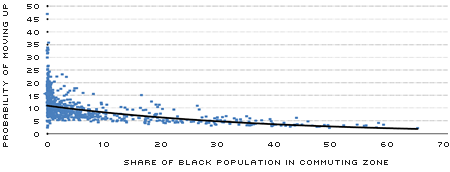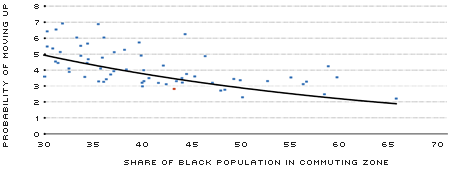District Overview: Why Is Economic Mobility in Memphis Among the Lowest in the Nation?
In the previous issue of the District Overview, we used economic mobility data from a study by economists Raj Chetty, Nathaniel Hendren, Patrick Kline and Emmanuel Saez (CHKS hereafter) to compare economic mobility in the U.S. versus the Eighth District. We focused on an indicator of economic mobility that measures a family's probability of moving from the bottom 20 percent of the income distribution to the top 20 percent in one generation.1 We found that the probability of doing this for people born in the Eighth District was 6.4 percent, which is lower than the national average of 8.1 percent. We also found that in Memphis, Tenn., one of the four largest metro areas in the District, the probability of moving up was among the lowest in the country, at 2.8 percent, while in 14 counties of the District located in Mississippi, the probability was even lower.2
In this issue, we introduce some factors that may be part of an explanation for the differences in income mobility across locations. Then, we look at potential explanations for the low economic mobility in Memphis. As before, we shape our analysis based on the results of the CHKS study, released earlier this year.
CHKS analyzed a set of 37 variables that can potentially help explain geographic differences in economic mobility. The economists highlighted five broad factors that seem to have the greatest statistical association with economic mobility. These factors are: (1) the share of black population and the degree of segregation; (2) income inequality as measured by the Gini Index; (3) quality of the school system; (4) social capital; and (5) family structure.
Analyzing how economic mobility is related to these factors is an important step toward building good theories of mobility. However, one must keep in mind that a strong statistical association does not guarantee that there is a causal nexus between potentially explanatory factors and economic mobility. The main concern is that economic mobility and the potentially explanatory factor may both be caused by a third variable.3
In this District Overview, we highlight the first factor: racial composition. We picked this factor for three reasons. First, CHKS found racial configuration to be strongly related to mobility at a national level. Second, this channel seems important for Memphis as this commuting zone has one of the highest shares of black population in the country: 43.2 percent. Third, studies of intergenerational economic mobility have found that upward mobility in the United States is lower for black households.
The figure plots the share of black population in the commuting zone and the probability of moving up. The data are looked at in two different ways: Panel A shows the universe of all commuting zones in the country, while Panel B focuses only on those commuting zones where the population is at least 30 percent black.
Panel A shows that both the level and the dispersion of economic mobility fall as we look at commuting zones with higher shares of black population. The added trend line shows that the average of these observations decreases from about 11 percent to about 2.5 percent as the black population share increases.
Since our question is about mobility in Memphis, Panel B focuses exclusively on commuting zones that are comparable to Memphis' in terms of the black population share. We picked those with a share above 30 percent and represented Memphis with a red marker.
Our first observation from Panel B is that mobility in all of these commuting zones is quite low. According to the data, knowing that a commuting zone has a black population above 30 percent is sufficient for inferring that the commuting zone has a probability of moving up of no more than 7 percent, which is well below the national average of 8.1 percent. This is a striking observation and the main fact highlighted by this District Overview.
In fact, looking only at racial composition and using the fitted trend line as a guide, a commuting zone with a 43.2 percent black population is expected to have a probability of moving up of 3.5 percent. The fact that mobility in Memphis is roughly 1 percentage point below this trend line suggests that other factors besides racial composition are reducing mobility in this commuting zone relative to other commuting zones with a high black share. We leave an investigation of other potential factors for future research on the economy of the Eighth District.
How can racial composition affect mobility? Unfortunately, there is no consensus about mechanisms that could be linking black share to upward mobility in a commuting zone. One potential link between these variables is as follows: If there is a racial gap in economic mobility such that black people have lower mobility than other people, then a higher fraction of black people in a particular commuting zone reduces measures of mobility for the commuting zone as a whole. This is simply known as a composition effect.
Some evidence for this composition effect can be found in a recent paper by economist Bhashkar Mazumder at the Federal Reserve Bank of Chicago. Looking at intergenerational income and earnings data from the Bureau of Labor Statistics, the Census Bureau and the Social Security Administration, Mazumder found that some measures of intergenerational mobility were persistently lower for black people in the U.S. between 1984 and 2007. The study also explored the potential role of educational attainment, family structure and parental wealth in explaining the black-white differences in mobility.
Conclusion
Racial composition seems important for understanding the low economic mobility observed in Memphis with respect to the U.S. as a whole. We point at a composition effect as the simplest possible mechanism that can produce a causal relationship between black population share and economic mobility. Under this mechanism, understanding the sources of the black-white gap in mobility seems a priority for future research on mobility across commuting zones.
Black Population Share and Mobility: All Commuting Zones

SOURCE: www.equality-of-opportunity.org.
Black Population Share and Mobility: Selected Commuting Zones

SOURCE: www.equality-of-opportunity.org.
NOTE: Plotted only for commuting zones with a black population share of at least 30 percent. The red marker corresponds to Memphis.
Endnotes
- CHKS arrived at this indicator by considering, for each commuting zone, the group of 14- to 20-year-olds whose family income was in the bottom 20 percent of the national income distribution in 1996-2000. The indicator is the fraction of that group that, as grown-ups (i.e., by ages 29-32), had a family income in the top 20 percent of the national income distribution. [back to text]
- These 14 counties are located in the commuting zones of Clarksdale, Miss., Yazoo City, Miss., and Greenville, Miss., where the measured probability of moving up was 2.7, 2.5 and 2.2, respectively. See Badel and Maues for further details. [back to text]
- For example, suppose a particular commuting zone has an environmental issue (such as high industrial pollution) that causes residents to have frequent respiratory infections. These infections could lead children in that commuting zone to perform badly in school, resulting in lower test scores, which would reduce the "quality of the school system." The same infections could lead to lower community event attendance, lowering "social capital." Finally, in the long run, these recurring health issues may lead to reduced economic mobility for children from this area. However, neither (3) nor (4) were the cause; the cause was the environmental issue. [back to text]
References
Badel, Alejandro; and Maues, Julia. "District Overview: Measured Economic Mobility in the District Is Below the U.S. Average." Federal Reserve Bank of St. Louis' The Regional Economist. April 2014, Vol. 22. No. 2, pp. 20-21.
Chetty, Raj; Hendren, Nathaniel; Kline, Patrick; and Saez, Emmanuel. "Where Is the Land of Opportunity? The Geography of Intergenerational Mobility in the United States." National Bureau of Economic Research, January 2014, Working Paper 19843.
Mazumder, Bhashkar. "Black-White Differences in Intergenerational Economic Mobility in the U.S." Federal Reserve Bank of Chicago, November 2011, Working Paper 2011-10.
Views expressed in Regional Economist are not necessarily those of the St. Louis Fed or Federal Reserve System.
For the latest insights from our economists and other St. Louis Fed experts, visit On the Economy and subscribe.
Email Us

